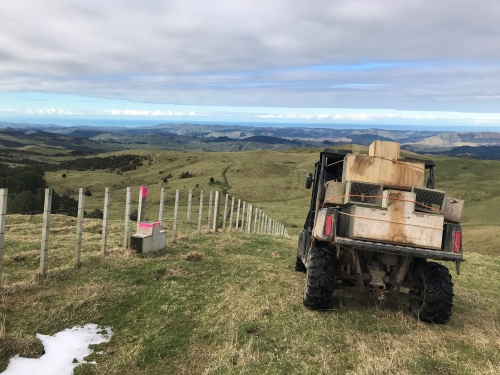

Feral cats have a significant impact on native wildlife, are significant predators across farmland in New Zealand, and can far out-number mustelids (ferrets, stoats and weasels). In Cape to City, approximately five feral cats were captured for every mustelid, a trend also reflected in predator monitoring results. Feral cats have been recorded consuming birds, lizards and invertebrates and are hosts of toxoplasmosis, a disease harmful to livestock, wildlife and humans.
Managing feral cats at scale is notoriously difficult and expensive, and finding ways to efficiently manage them is an important part of New Zealand’s Predator Free 2050 goal.
Currently, most cat control is live capture and kill traps, despite poison baiting being typically more cost-effective due to reduced labour costs and capital investment (i.e. purchase of traps). However, poison bait for feral cats has had little use on mainland New Zealand due to a lack of effective and humane baits, risks to non-target individuals (e.g. domestic cats and dogs), and little research on the population impacts from largescale control or the rapidity of reinvasion.
Para-aminopropiophenone (PAPP) was first registered in New Zealand in 2011, is more target-specific than other toxins, and has been shown to kill cats humanely. A 2017 Hawke’s Bay field trial over 1,000 hectares showed the potential for PAPP as an effective, cheaper, and less time-consuming alternative to trapping. Following this successful trial, a larger trial in 2018 covered 9,123 hectares of the Poutiri Ao ō Tāne project area in Hawke’s Bay. The trial aimed to estimate the feral cat population before and after the trial and compare the efficacy of PAPP to other control methods.
Both trials supported New Zealand’s Predator Free 2050 goal of larger and more ambitious mainland landscape scale predator control projects trialling a range of tools for effectiveness.
Camera traps were used to monitor the number of feral cats on Opouahi Station (treatment site) and at Waitere Station (non-treatment site). A network of 287 bait stations was established in 500m grid spacings across the treatment site.
Two applications of non-toxic pre-feed minced meat baits were followed by two applications of toxic PAPP baits. PAPP baits were dyed green and contained 80 mg of PredaSTOP® in the centre of the bait. Each application of PredaSTOP® consisted of two baits placed at either end of each bait station.
Toxic baits were removed from at least 130 bait stations, with a likely result of at least 130 feral cats killed. This resulted in a 39% reduction in the relative abundance of feral cats after the operation.
This reduction in feral cat detections and potential number of kills was achieved at less effort and cost than conventional techniques such as live capture. However, this 39% reduction is less than we would have expected from previous trials. Rapid immigration of feral cats following the operation could mean PAPP is unlikely to have long term results when used on its own. Further trialling is recommended to explore effectiveness of annual operations through time, and the effect of rabbit numbers in control areas.
12 April 2021
Disclaimers and Copyright
While every endeavour has been taken by the to ensure that the information on this website is
accurate and up to date, shall not be liable for any loss suffered through the use, directly or indirectly, of information on this website. Information contained has been assembled in good faith.
Some of the information available in this site is from the New Zealand Public domain and supplied by relevant
government agencies. cannot accept any liability for its accuracy or content.
Portions of the information and material on this site, including data, pages, documents, online
graphics and images are protected by copyright, unless specifically notified to the contrary. Externally sourced
information or material is copyright to the respective provider.
© - www.pfhb.nz / +64 6 000 0000 / info@website.co.nz